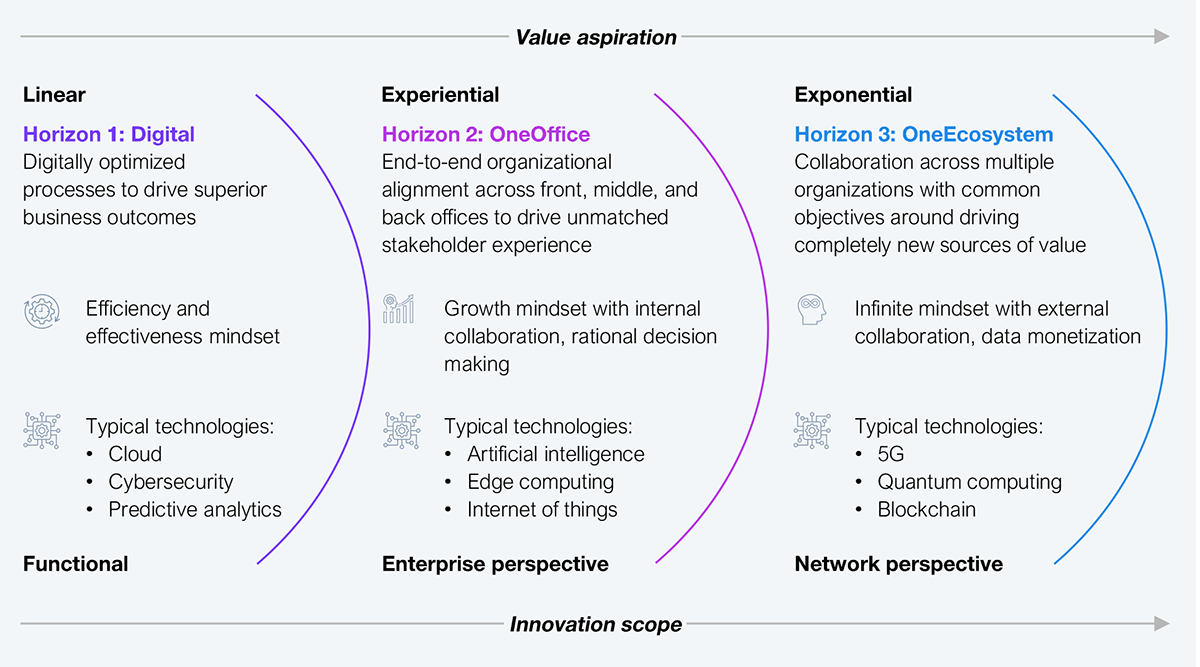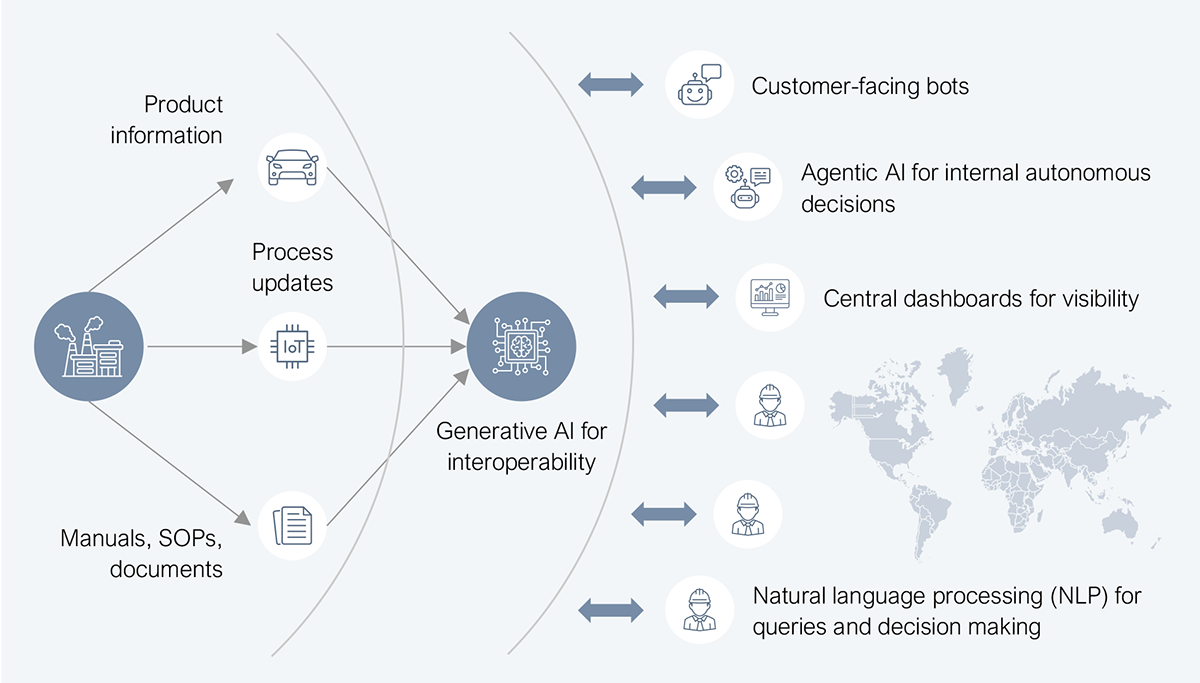Most global capability centers (GCCs) or offshore subsidiaries remain stuck in cost and skills arbitrage, with only 35% of them innovative and forward-looking. The rest? Fifteen percent (15%) of GCCs continue to focus on archaic cost arbitrage, while 50% of them focus on developing technical expertise. CIOs who keep GCCs in cost-arbitrage mode will lose innovation velocity, P&L impact, and competitive differentiation. Most GCCs have a mismatch with the overall organization’s objectives and need a rethink, orchestrated by AI.
GCCs are on a growth trajectory in India. Twenty-four (24) of them surpassed the $1 billion export revenue mark in 2023–24, doubling in count in five years. For innovative GCCs to evolve beyond back offices contributing cost savings to also contribute revenue, their CIOs should adopt a OneOffice concept, breaking organizational barriers to focus on value creation. The three horizons in this GCC evolution, characterized by increasing levels of value creation and innovation, progress through Horizon 1, featuring digitally optimized processes for efficiency, and Horizon 2, with end-to-end organizational alignment for a OneOffice concept, then on to Horizon 3, which features collaboration across multiple organizations to achieve OneEcosystem (see Exhibit 1).

Source: HFS Research, 2025
Enterprises whose GCCs remain as cost arbitrage shops end up implementing programs driven by headquarters, with slower innovation cycles, higher vendor dependency, and a lag in AI adoption. On the other hand, the AI-powered Mercedes-Benz User Experience (MBUX) infotainment system was conceptualized and built in the Mercedes-Benz GCC in Bangalore, India. Innovation is not limited to products! Ford’s GCC in Chennai, India, progressed from transactional finance operations to product engineering and even the setup of digital twins for facilities to optimize and improve their performance.
A recent strategic workshop hosted by Wipro convened senior leaders from across the energy value chain to explore the next frontier of AI-infused GCCs. The dialogue centered on unlocking operational value through remote asset management, with participants exchanging best practices, transformation lessons, and key value drivers shaping the future of GCCs.
As part of the engagement, a curated visit to Wipro’s Innovation Lab offered firsthand exposure to emerging physical AI technologies, including autonomous drones, robotic quadrupeds, and industrial automation platforms. These innovations underscored the potential impact of AI across upstream, midstream, and downstream operations in the energy industry.
When creativity itself becomes data-driven, geography loses its grip on value creation. With data accessible from anywhere, GCCs now have the opportunity to deliver outcomes indistinguishable from those once rooted in the home market of the enterprise.
— Sandeep Dhar, Global Head, GCC practice at Wipro.
Despite these developments, a mismatch remains between organizational and GCC corporate objectives for many enterprises. While the top three agenda items for the CEO and the board are to grow the top line, bottom line, and compliance, the top critical factors for a GCC are compliance, geographic expansion, and the launch of new business models. This mismatch should be flipped. GCCs should focus on top-line growth. Global enterprises face a slowdown due to macroeconomic and geopolitical headwinds, budget and talent shortages, speed-to-market risk, stranded investments, and competitive drag. Simultaneously, they are expected to gallop quickly due to the pace of digital transformation. GCCs balance these two market forces, enabling companies to innovate rapidly and cost-effectively.
GCCs in India’s energy sector have progressed from being digitization hubs to developing niche skills, including subsurface characterization and drilling, low-carbon solutions, and new product development. Local leadership has discussed how GCCs have become central to the organizations’ global operations, specifically in areas such as AI-based platforms for energy management, advanced engineering and analytics, digital solutions, and digital twins, with wage arbitrage being the least relevant factor.
Existing and greenfield GCC leaders should include AI as a thread to break silos between the GCC and other teams and set up seamless collaboration, with no cultural, organizational, or technical barriers. Combinations of structured and unstructured data, along with insights from diverse sources in factories and plants, should be fed into large language models (LLMs) for enhanced interoperability (see Exhibit 2). The LLM serves as a sounding board, bringing together multiple teams across geographies, functions, and time zones to enable them to work coherently, regardless of language or area of interest. Hallucinations can be costly in the industrial world, and they must be avoided by validation and verification, with a human in the loop, and with ongoing feedback and fine-tuning of the model.

Source: HFS Research, 2025
Siemens, for example, is developing its Industrial Foundation Model, a generative AI model trained on 150 petabytes of industrial, engineering, and manufacturing data. The model can communicate in the language of engineers and support them in use cases such as CNC programming, manufacturing planning, and connecting bills of materials to robotic simulators, as well as simulation and validation of manufacturing processes. Schneider Electric has developed an LLM for measuring and reporting carbon emissions. Data from smart meters, invoices, and customer inputs is fed into the model, allowing for easy querying of the LLM in simple language. Such implementations can also be extended across the entire energy value chain.
Business leaders should redesign their GCC charters to reflect the overall enterprise’s P&L outcomes, rather than focusing on cost savings and local metrics. They should mandate AI-platform alignment across GCCs and the headquarters to eliminate silos. Performance metrics for GCCs should be shifted from efficiency to the velocity and quality of innovation. The next stage beyond OneOffice is a OneEcosystem approach, where upstream suppliers and downstream stakeholders, such as dealers and retailers, are also included in the innovation process for exponential growth.
GCCs that focus on innovation can expect to receive a larger portion of the overall R&D budget allocation, file more patents more quickly, commercialize them through new product introductions into the market, translate them into good sales, and create a virtuous cycle.
Register now for immediate access of HFS' research, data and forward looking trends.
Get StartedIf you don't have an account, Register here |
Register now for immediate access of HFS' research, data and forward looking trends.
Get Started